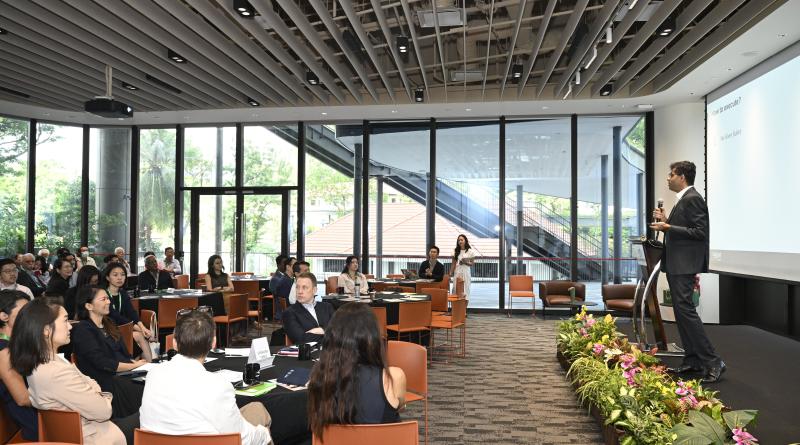'Frugal innovation' and 'boring solutions' can best accelerate climate action, say experts

Companies should approach climate solutions as a “portfolio management exercise”, and look for short-term wins by tweaking their operations, said industry leaders.
In their quest to decarbonise and address the effects of climate change, companies and investors are often tempted to go big by seeking out headline-grabbing ideas. However, that might not be the most effective way to implement climate solutions, according to experts.
“I can tell you from experience that the most impactful (solutions) are the most boring ones, which you will not see in the news,” said Vinamra Srivastava, chief sustainability officer at real estate firm CapitaLand Investment Limited. He was speaking at the Cities: Possibilities event on Friday organised by Eco-Business.
Srivastava cited the example of CapitaLand improving the efficiency of its building’s cooling systems, which resulted in 10 per cent (energy) savings. “Nobody is going to put it in the papers (but) of course it’s moving the needle. Multiplying this (kind of action) by 10, 15 times — that’s what the private sector needs to do,” he said.
Such scalable, efficiency-driven initiatives need not be limited to the energy sector, as they can also be used to improve food security.
“In food innovation… some ideas are better than others,” because they are more efficient and address problems quicker, said Xiuling Guo, newly appointed chief executive officer of sustainable food platform Nurasa. “It doesn’t have to be rocket science. Some of the innovations in food actually require a huge amount of discipline.”
Goh called for entrepreneurs and investors to adopt the “frugal innovation” mindset. “Just think about how you can use the least effort to create the biggest impact,” she said, pointing to how Singapore already has plenty of infrastructure that entrepreneurs can leverage on, instead of investing unnecessarily in more infrastructure. “To be responsible as an innovator (is) to use more shared infrastructure,” she said.
Hannah Jones, chief executive officer of The Earthshot Prize, shared a passion for seemingly small but scalable solutions. “I love boring; boring is great,” she said. “Sometimes it is about chipping away at a boring 10 per cent (solution) that could be easily scaled and replicated across a company or a city.”
The Earthshot Prize, which was founded by Britain’s Prince William and funds innovative climate change solutions, has also rewarded what Jones described as a seemingly simple solution: a policy to tackle food waste in Milan. “We said that they deserve to win because no one talks about food waste, but it is a massive source of carbon emissions and also a massive poverty and inequity issue,” she said.
Jones, who was previously chief sustainability officer at Nike and later vice president of its Innovation Labs, also shared that her relentless focus on waste at the apparel company turned it “from the most boring to the most exciting thing.”
“It converted the chief financial officer at the time [to value waste as a resource]…because suddenly he was like, ‘This (waste) is money coming straight back into the company. It’s amazing,’” she said. Since the 1990s, Nike has incorporated discarded or donated waste materials in the production of its apparel and shoes, based on programmes such as Nike Grind.
Private sector prudence
But how can organisations decide which solutions to prioritise? According to Srivastava, companies should approach potential decarbonisation solutions as a “portfolio management exercise”, with organisations weighing up which investments or high-emissions activities should be phased out first and a calculation made to determine what would create the most impact in the short term. Such an approach is likely to involve experimenting with multiple solutions, some of which might not work out in the short run but could offer future returns.
“If private companies keep this in mind, then the way they invest in innovation and technology will be more prudent for them to address long-term challenges,” said Srivastava. CapitaLand, for example, was able to reduce its utility bills and eventually improve financial performance by making its buildings more energy-efficient.
“If [a particular solution] also creates an immediate, short-term win for the bottom-line — bingo; do it. And use that as a wedge in the door to develop something that might be more costly and risky, but could also bring longer-term returns,” said Jones.
It will also cost companies more if they do not address climate change and their emissions, said Srivastava. Beyond “brute force measures” such as policy-driven carbon taxes and bans on petrol-fuelled vehicles, businesses will increasingly lose out if they don’t act now, he said.
“There may not always be customers who are going to pay a green premium for energy efficient buildings, but there are definitely those who will penalise you by not choosing your building,” said Srivastava. “Companies must quantify these costs and turn them into opportunities that make topline [revenue-generating] sense for the business.”
The more companies that do this, the more conversations about climate change can be elevated from being “theoretical, nebulous and fluffy” to actually addressing the concerns of all stakeholders involved, said Srivastava.
Energy efficiency was a popular topic among attendees of the event, as breakout groups for roundtable discussions saw most choosing to discuss power-related concerns. Attendees also discussed issues of poor access to clean and affordable drinking water, as well as factors that would encourage local food production. Across all topics, common issues identified included the lack of project-level funding for climate solutions and the need for better policy support to help climate innovations reach commercial viability.
Nudging behavioural change
On the subject of consumer behaviour, other speakers at the event described the need for behavioural change in driving climate solutions. Tracking urban behavioural data will become more important over time, with “urban tech stacks” set to become an important tool to gather such information, said Joe Hopper, director at the United Nations Development Programme’s Global Centre for Technology. These data points can then be made publicly available to encourage the development of solutions by the private and non-profit sectors, he said.
The behaviours of city-dwelling Southeast Asians should also be factored into sustainable cooling measures, said Lee Poh Seng, associate professor at the National University of Singapore (NUS) and executive director at the Energy Studies Institute. Although it has long been convenient to simply turn on air-conditioning, which has also been considered a symbol of greater wealth, this ultimately generates more energy waste and worsens urban heat, he said.
“But folks have been staying in this part of the world for centuries, so we can actually tolerate higher temperatures. Instead of relying on mechanical cooling, we can look into integrating passive cooling designs or strategies,” said Lee. Examples include designing for sufficient shading and greenery, as well as better ventilation to ensure cooling without using mechanical equipment.
Lee is trying to walk the talk. “Since last year, I set my office temperature to 27-degrees Celsius, 2 degrees higher than the NUS guidelines,” he said. “I felt a bit uncomfortable at first, but within two to three months, my body acclimated to the higher temperature.”
Academia also needs to step up its role in implementing climate solutions, said Lee. “We can do more (to) move research outcomes and innovation findings out of universities, which are usually only published in journals or talked about at academic conferences,” he said.
“What is more important in addressing the grand challenges of sustainability and decarbonisation is [for researchers to take] a problem-driven approach,” said Lee. “It should be the industry or government providing their pain points, with academics working alongside them to conduct use-inspired research that can be translated into deployable solutions.”
One way to do this is to create sandboxes within existing production systems, said Lee. He is part of the academic team working with tech companies to investigate sustainable cooling methods for data centres in the tropics. Singapore’s data centres consume almost seven per cent of the country’s total energy output, an amount projected to reach 12 per cent by 2030.
Image: Eco-Business





